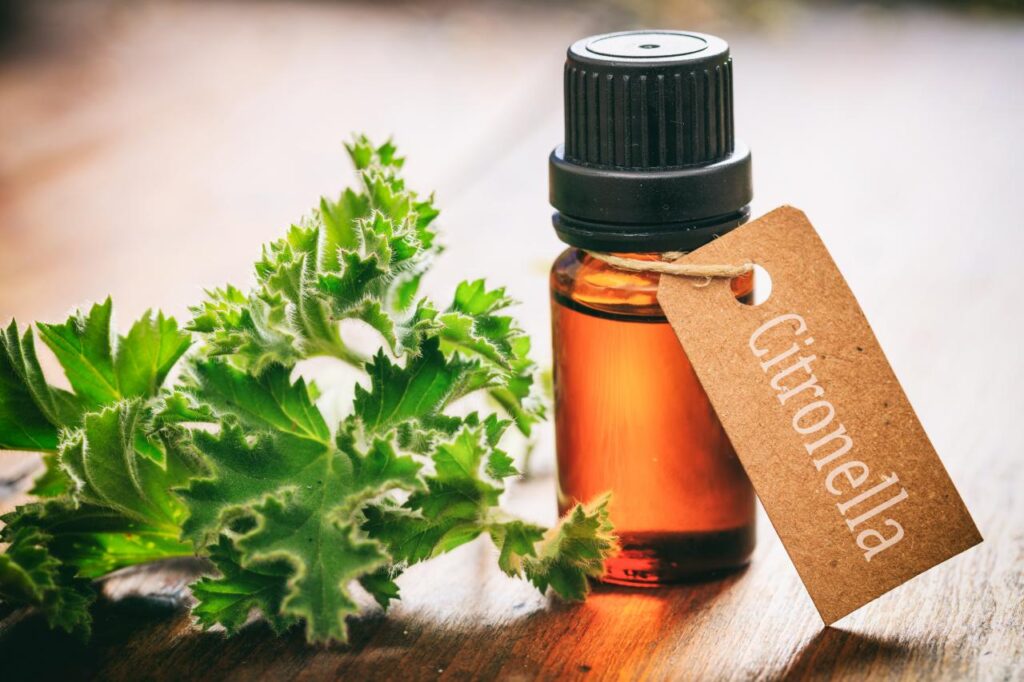Essential oils work wonders in not just humans but also dogs. Pet owners have used it for generations to reduce the pain of dogs.
But the tolerance of dogs for essential oils is different than us humans. So it is necessary to consult with a certified veterinarian before introducing critical oil into your dog’s healthcare.
Essential oils have many possible, desirable effects. The effects include: reducing anxiety, minimizing inflammation, and fighting oxidative processes.
Many people use it to battle toxins in your dog’s body and fight infections by inhibiting bacteria, viruses, and fungi. [1]
Essential oils also work as aromatherapy for dogs.
In this article, you’ll learn all about 10 essential oils and how to use essential oils for pain in dogs.
Inside the article:
- Best essential oils to treat dog’s pain, itching, and anxiety
- Methods of using essential oils for pain in dogs
- General safety tips

Use 10 Essential Oils to Relieve Dog’s Pain, Itching, & Anxiety
It is essential to use the essential oil properly on dogs with proper instructions from your veterinarian.
Here are some safe essential oils to be used on dogs with the correct measures:
1. Lavender Oil
Lavender is the soothing essential oil to use on dogs. This gentle oil helps with various health problems in dogs, including burns, bruises, grazes, flea bites, repels fleas, anxiety, hyperactivity, and fungal infections.
It also works as a mild sedative, antiseptic and relaxing agent.
Do not use lavender oil if the cut is too deep and you are unsure if there is any risk of infection. [2]
RELATED: 11 Health Benefits of Lavender Oil That You Should Know
2. Yarrow Oil
Yarrow has excellent healing properties for cats and dogs. It could be used externally to stop bleeding quickly.
It should be kept in your dog’s medical kit for emergencies. It also helps with itchy skin, allergies, stings, ear infections, kidney infections, anti-inflammatory for sprains and pulls or arthritis, and physical or emotional trauma. [3]
3. Lemon Oil
You should use this essential oil with caution as it could also harm dogs when not used correctly. Using lemon oil for dogs can cause burns, redness, and other sensitization when sun exposure. [4]
That said, lemon oil is good for arthritis and kidney stones. In addition, it can clear mental confusion in dogs.
Lemon oil may increase the concentration and assimilation of new information. It can increase trust in self and others.
It also works as an anti-diabetic, anti-anemic, anticoagulant, antifungal, antisclerotic, antiseptic (air), and antispasmodic (stomach) agent for dogs.
RELATED: 10 Ways Lemon Oil Can Benefit your Health
4. Cedarwood Atlas or Himalaya Oil
This oil has antifungal and antibacterial properties in it. It is natural and non-toxic.
This oil can be used as a natural pesticide and insect repellent. It also works as an antiseptic for the lungs and catarrhal, an expectorant for coughs, such as kennel cough, stimulates circulation, etc.
But confirm with your veterinarian if your dog has any allergies or sensitivity to Cedarwood Atlas. [5]
5. Helichrysum Oil
This oil is a little expensive, but it is excellent for dogs. It helps with treating cuts and bites that dogs frequently get.
It also heals broken capillaries, soft swellings, broken bones, deeply bruised emotions, resentful anger, anti-viral, anti-allergenic. In addition, this oil is perfect for dogs’ liver and digestive processes.
Here are some other oils that are safe to use on dogs.
6. Angelica Root Oil
Angelica root oil helps your dog feel a sense of protection, allowing him to feel secure after they go through any trauma or fear.
Your dog’s mind will use it as an energy medicine to power up. Angelica root oil helps dogs who shut down due to chronic pain or stress.
This oil helps dogs overcome their weaknesses and works as a treatment. It allows dogs who show any irrational fear that started after a traumatic incident in their early life. [6]
7. Citronella oil
Citronella oil is a natural insect repellent. It can also treat dogs’ pain and inflammation.
Citronella oil can decrease rashes on the dog’s body and fight infections. It can also treat several health conditions,
Citronella oil contains some powerful anti-inflammatory properties. It also offers calming and soothing effects on internal inflammation.
The smell of citronella can be powerful. Be careful with the amount you use on your dog. [7]
8. Frankincense Oil
Frankincense oil can help to calm animals and ease anxiety. In addition, this oil might help animals by reducing cancer risks, tumors, external ulcers, etc.
Frankincense oil can strengthen the immune system of dogs. This oil can help reduce stress reactions and get rid of negative emotions. [8]
9. Spearmint Oil
If peppermint oil is too strong for your dog, you can use spearmint oil instead. Spearmint oil has a distinct aroma. Mixing two of them could be another way to use it. It is gentler on dogs.
Spearmint oil has two chemical constituents named cis-carveol and carvone. These compounds have antimicrobial properties that kill threatening microorganisms.[9]
Spearmint oil also has antiseptic properties that help protect wounds and ulcers from infection. It can even help them heal faster. [10]
Spearmint oil can help support weight loss in dogs. In addition, it can address issues like diarrhea and colic.
Spearmint oil can aid in balancing the metabolism and stimulating the bladder. However, it would help if you used it diluted in small amounts over the short term.
This oil can help with a lot of gastrointestinal issues in dogs.
RELATED: 12 Uses and Health Benefits of Peppermint Oil
10. Cardamom Oil
Cardamom oil can normalize a dog’s appetite, soothe nausea and treat a cough. It also improves the digestive and respiratory systems. [11]
Cardamom is a natural diuretic. It also has some antibacterial and antimicrobial properties.
It can calm the stomach upset of a dog and maintain optimal gastrointestinal balance. [12]
Cardamom oil helps stimulate the dog’s entire system. This effect can also boost the dog’s spirits in depression or fatigue.
Methods of Using Essential Oils for Dog’s Pain
You can use essential oils on dogs, but proper measures must be taken. In addition, adjusting to anything new takes time. Therefore, you need to introduce essential oils to your dog.
Start with a small amount to be safe and dilute it properly. Then, you need to see your dog’s reaction to it carefully.
If you see that the response is neutral, but you are still not getting the therapeutic effect you hoped for, you can always add more or increase the frequency of application.
Remember that you should not start the treatment with a large amount right from the beginning.
- Pet along the spine – It is the best-tolerated form of application on pets.
- Ear tipping– Apply the diluted oil to the tips of your dog’s ears. Notice if your dog seems to be irritated with this form of application. Avoid using this type of application if your dog has long ears. They sometimes shake their head and get the oil in their eyes by accident.
- Applying to paws –Make sure you get the essential oil on the skin between your dog’s paw pads. This is a sensitive area, so be careful and use dilute oils.
- Water misting – Add a drop of oil to several ounces of water in a spray bottle. Shake it well before use, then spritz it on the pain area. This is also helpful for large dogs if you are trying to cover a larger room or they cannot tolerate regular handling.
- DIY – Add topical products such as shampoo or coconut oil with your essential oil according to what might suit your dog.
- Indirect application – Apply essential oil to bedding or an area your animal frequently comes into contact with for it to work as aromatherapy when they rest. [13]
Tips and Precautions
Some essential oils could be very harmful to dogs. Therefore, pet owners should never use them without consulting with experts.
Some essential oil products that are for humans can hurt animals. Dogs are higher in sensitivity and smaller in size compared to us. This makes it crucial for pet owners to be aware of potential dangers.
Essential oil treatments impact animals differently than humans. There are variable tolerance levels for dogs and humans.
Before using essential oils on dogs, one must thoroughly research the possible safety issues from reliable information sources. Some oils can be toxic; the professional veterinarian should always administer them. [14]
Here are some tips and words of precautions that you should keep in mind while using essential oils on dogs:
- Buy therapeutic brands with no harmful chemicals for dogs from well-known companies.
- Check if there is rhetoric on their labels “for internal use” before buying if your dog will be ingesting them.
- Read carefully on the label how to dilute oils before you use them, so it is not too harsh on the fog.
- If your dog has a pre-existing medical condition or it is under 10 weeks old, you should consult with the veterinarian.
- Stop using essential oil immediately if you see your dog has an adverse reaction.
- Before using, do proper research, and do not overboard with the essential oil use.
- Also, monitor your dog’s behavior. For example, if you see he does not like essential oils, then do not force them on your dog.
Bottom Line
While using an essential oil on your dogs can help achieve better health, knowing the proper treatment method is necessary.
Dogs have a very much higher sense of smell than humans. They use their sense of smell to acquire complex information from the environment. Then they use that information to calculate and predict what states of energy and response they should adopt.
So, it is essential not to overpower the smell of essential oils as it may disrupt their natural brain activity.
Before attempting to use essential oils to treat a dog’s pain, it is crucial to know that even a minimal amount of these essential oil compounds can have potent biological effects on every system of the dog’s body.
With that being said, essential oils can offer a multitude of benefits for the better health of your pet and work as a substitute for harsh medicines. So, if you have the proper knowledge and a veterinarian’s green signal, make the best use of them.
I hope this article was helpful. For any questions, leave a comment in our comments section below.
READ NEXT: 15 Home Remedies for Ear Mites in Dogs That Works





